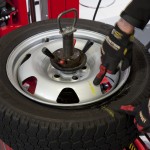The modern cars of today are designed to drive smoothly and handle safely. Unchecked excessive wheel balance wheel vibration can cause:
- Excessive tyre wear – leading to a greater cost of continually replacing the tyres.
- Damage to suspension and steering part
- Unsafe steering and handling
What is the difference between Standard Balancing and Road Force Balancing?
Standard balancing
A wheel is spun and the standard balancer identifies the imbalance in the wheel assembly. Weights are applied opposite the heavy area, so when spun the wheel rotates without imbalance.
Road Force Balancing
A wheel is spun and a standard balance measurement is taken but in addition to this the wheel is also taken on a simulated road test. This is where a load roller is lowered onto the wheel, putting the wheel under load to simulate actual road force. This additionally identifies:
1) Road Force Variation: if the wheel is out of round (Run out) or there is uneven tread/tyre wall stiffness. All of which are contributing to vibration over and above that caused by simple imbalance.
2) Lateral Force: The amount of conicity ( the amount of Flex) in the tyre wall, which when excessive can cause the car to pull.
How is excessive Road Force Corrected?
By the technician rotating the tyre on the rim; so aligning the stiff spot in the tyre to the low spot in the rim. This is called ForceMatching™ and solves the vibration.
Occasionally tyres and rims with excessive Road Force cannot be matched and therefore must be replaced.
How is excessive Lateral Force Corrected?
When all four wheels have been on the Road Force balancer, the balancer will number tag each wheel and give the technician the best wheel placement plan for the wheels on the car. This will minimise the car  pull effect.
pull effect.
Will Road Force Balancing alone solve all vibration and pull issues?
Road Force balancing is extremely effective, but should be considered in addition to regularly checking Tyre pressures and having a proper four wheel alignment (see www.alignmycar.co.uk ). Other hidden causes of vibration could be due to wear and tear or failure of certain components, such as steering, suspension parts, brakes, drive train or engine parts.
When should I have my cars wheels Road Force Balanced?
If you feel excessive vibration (e.g. through the steering wheel or at speed) it should be checked. It is wise to have it checked every time you change the tyres on your car or every 10,000 miles or once a year – as gradual worsening of wheel vibration can be difficult to notice. Do follow any vehicle manufacturers recommendations found in the owners manual.
